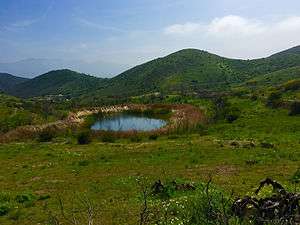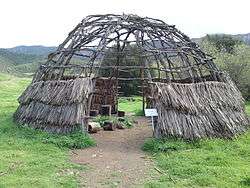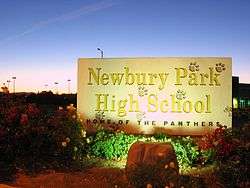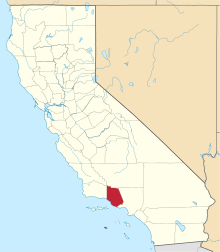Newbury Park, California
| Newbury Park | |
|---|---|
| Populated place[1] | |
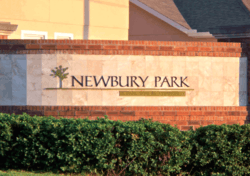 | |
 Newbury Park Location in California | |
| Coordinates: 34°11′03″N 118°54′35″W / 34.18417°N 118.90972°WCoordinates: 34°11′03″N 118°54′35″W / 34.18417°N 118.90972°W | |
| Country |
|
| State |
|
| County | Ventura |
| Area | |
| • Total | 21.0 sq mi (54 km2) |
| • Land | 20.5 sq mi (53 km2) |
| • Water | 0.5 sq mi (1 km2) |
| Highest elevation | 2,828 ft (862 m) |
| Lowest elevation | 500 ft (200 m) |
| Population (2010) | |
| • Total | 37,775[2] |
| • Density | 1,772/sq mi (684/km2) |
| ZIP Code | 91320[3] |
| Area code(s) | 805 |
| GNIS feature IDs | 2585446[1] |
Newbury Park is a town[4][5][6] located mostly within the western Thousand Oaks city limits in Ventura County, California, United States. It makes up all of ZIP code 91320, and is within area code 805. Lying within the Conejo Valley in the northwestern part of the Greater Los Angeles Area, Newbury Park abuts the Santa Monica Mountains. It is approximately 35 miles (56 km) from Downtown Los Angeles and less than 7 mi (11 km) from the Los Angeles County border in Westlake Village. The closest coastal city is Malibu, 22 mi (35 km) from Newbury Park, which may be reached through winding roads or hiking trails crossing the Santa Monica Mountains. About 28,000 of Thousand Oaks' 110,000 residents reside in Newbury Park.[7] Newbury Park makes up around 40 percent of Thousand Oaks’ total land area.[8]
Newbury Park, along with Thousand Oaks proper, have numerous times ranked among the safest and also wealthiest communities in the United States.[9][10] Money Magazine has ranked Newbury Park as one of the most affluent cities in the United States. It has the 11th highest per-capita income and the fourth-highest median household income in the country.[11] As of 2013, the median household income in Newbury Park is $107,302, compared to $60,190 for California as a whole and $53,046 nationwide.[12][13]
Etymology
Timberville was a previous 19th century name for Newbury Park.[14][15][16] Newbury Park is named after Egbert Starr Newbury, who was the founder of Newbury Park,[17][18][19] as well as the first postmaster in the Conejo Valley in 1875.[20][21][22] Egbert Starr Newbury called his ranch here “Newbury Park”, which ultimately became the name for the entire town.[23][24][25] Egbert Starr Newbury and his family owned thousands of acres in the Conejo Valley, but only lived in Newbury Park for a total of six years. He moved from Michigan to Southern California for health reasons in 1871, opened Conejo Valley’s first post office in 1875, but left California only two years later. The Newbury Park Post Office has changed locations numerous times but the Newbury Park name has survived and is still used even though much of the area was incorporated into the city of Thousand Oaks.[26]
Egbert Starr Newbury chose the name "Newbury Park" due to its similarities to a park, he believed the area looked like a park community and therefore ought to have "park" in its name.[27][28][29][22]
History
Pre-colonial period
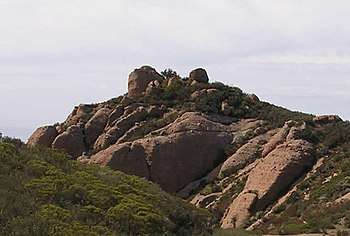
The first written material on the Conejo Valley was written by anthropologist John P. Harrington in about 1900; he wrote that this is what he was told by the local Chumash People:
Early one morning in 9080 B.C., the ancestral grandfather from whom I took my name, headed west on one of his most adventurous hunting trips ever… As the group climbed Old Boney, they looked back to the north and could see the pleasant openings of the Conejo- and Hidden Valleys. There, there appeared to be good grazing ground for the mammoth herd and they proceeded thence.[33]
This story may be related to the lore about the Paleo-Indians, who are believed by some to be the distant ancestors of the Chumash.[34] Mammoth fossils were unearthed in Newbury Park in 1961 and later in 1971, and are on display at the Stagecoach Inn Museum.[35] The Newbury Park area is believed to have been inhabited by people of the Chumash culture for at least the past 6,000,[36] 7,000,[37] 8,000,[38] or perhaps 10,000 years.[39][40] Newbury Park has been home of three Chumash villages: Satwiwa by the southern edge of town, as well as two villages that were located by today's Ventu Park Road. These villages were settled 2,000 years ago, and had a population of 100–200 inhabitants in each village.[41][42] In addition to those three, a large Chumash village was located just north of Arroyo Conejo Open Space by Wildwood Regional Park.[32] Other nearby villages include Lalimanux (Lalimanuc or Lalimanuh) at the base of the Conejo Grade by westernmost Newbury Park,[43] as well as Kayɨwɨš or Kayiwish (Kawyis) (CA-Ven-243) also by the Conejo Grade.[44][45] This region contains numerous pictographs.[46]
Newbury Park also contains many ancient burial sites, most near the Santa Monica Mountains in the southern portion of the community. Many burial items have been discovered in the area, most notably by Rancho Sierra Vista in southern Newbury Park. Satwiwa, which is Chumash for "the bluffs", was the name of a nearby village by the Big Sycamore Canyon. The canyon was a popular trading route for the Chumash- and Tongva people, connecting the Conejo Valley to Mugu Lagoon through the Santa Monica Mountains.[47][48][49] Unlike Satwiwa, which is now protected as a part of the Santa Monica Mountains National Recreation Area,[50][51][52] the two other Chumash villages once located within Newbury Park are located on private lands by Ventu Park Road. These are known as CA-Ven-65, CA-Ven-261, and CA-Ven-260 near the Fieldhouse in Newbury Park. At CA-Ven-261 is an ancient Chumash burial site as suggested by a village of long duration.[53]

The Ventureño Chumash initially settled in the west end of the Santa Monica Mountains because of the abundant food supply. Roots, berries, seeds, bulbs, acorns and walnuts, were plentiful in the region, and a variety of wildlife including birds, deer and squirrels made for good hunting. Shellfish and fish were transported from the nearby Mugu Lagoon across the Santa Monicas.[54] Here they also discovered an abundance of jackrabbits and other rabbit species, which were hunted widely for fur and meat. At one point, the Chumash here gathered a group of 27 men and killed hundreds of rabbits during a rabbit round-up, which was a significant event of late summers in the Conejo Valley.[55] Along with Rancho Sierra Vista, various Chumash artifacts from these older settlements, along with petroglyphs, have been found along the Arroyo Conejo, particularly in the Santa Monica Mountains.[56][57] The Satwiwa Native American Indian Culture Center and the Stagecoach Inn Museum in Newbury Park have displays built around some of these finds,[58] as does the Chumash Indian Museum in Thousand Oaks. In partnership with Friends of Satwiwa, the National Park Service began talks of establishing the current Satwiwa Native American Indian Culture Center and Natural Area in 1978.[59][60] Boney Mountain in southern Newbury Park is now a sacred site for the Chumash, and nearby Satwiwa is frequently used by the Chumash Barbareño-Ventureño Band of Mission Indians for private events such as traditional dances and sacred ceremonies.[61][62][63]
19th century
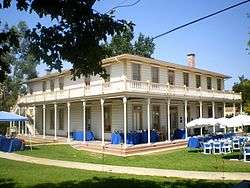
When the Europeans first arrived in the Conejo Valley, they pressed plow to furrow and fields to barley and wheat.[64] Newbury Park is named after its founder, Egbert Starr Newbury, who owned thousands of acres of land in the Conejo Valley and who later became the first postmaster.[24][25] E.S. Newbury, Howard Mills, and John Edwards were among the first to buy former Rancho El Conejo land in the early 1870s.[65][66][67] El Rancho Conejo was an area which today encompasses most of the Conejo Valley and was named for its many rabbits. Its name derives from a Spanish land grant in California, encouraged by the Spanish- and Mexican governments.[68]
Newbury and his wife Fannie moved to California from Michigan of health reasons in 1871 and he later became the first postmaster in the Conejo Valley in 1875. The post office was near their house which was located at the current location of the Thousand Oaks Civic Arts Plaza. E.S. Newbury purchased 2,200 acres of land in 1874, which stretched from today's old town Thousand Oaks and into Hidden Valley in southern Newbury Park.[69]
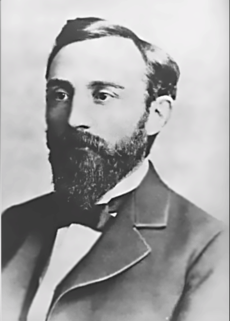
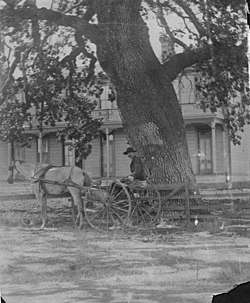
In the 1870s, Egbert S. Newbury and his wife, Fannie, moved full-time to their ranch in Conejo Valley, in which they named “Newbury Park” because the land looked so much like a park community.[72][73] It consisted of his house, barn, and a guest house for people to come visit to “enjoy the healthful climate”, according to E.S. Newbury.[73] The area was remote and only five families lived in the Conejo Valley at the time, all on large ranch lands. The ranches were miles apart and there were no grocery stores, medical facilities, schools, or churches in the valley.[74] He had acres of wheat and owned thousands of sheep. The weather had a great impact on E.S. Newbury’s health, and he wrote to his sister Kittie home in Michigan on November 23, 1874: «take wings and come to Conejo and enjoy our warm bright days all winter… be outdoors instead of confined indoors… I am out all the time and our drives now are just lovely with the country all turning green. The birds stay around our house in flocks all the time… Our roads to the ranch are splendid and they lie through beautiful canyons and large groves of live and white oak and sycamore, then into an open valley with slopes and surrounding hills covered with evergreen oaks…».[75]

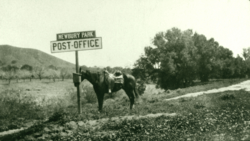
As a result of the increasing interest in the developing Conejo Valley, Newbury functioned as a public relations representative for the Conejo Valley. On December 25, 1875, E.S. Newbury wrote in the largest newspaper in Ventura County at the time, the Ventura Signal, the following words about Newbury Park:
«Next to Ojai and Santa Ana ranchos, the Conejo mountain valley has the best reputation as a health resort. It is well fifteen miles from Port Hueneme. The soil is immensely fertile, producing large crops of wheat and other grain…».[76]
Before Newbury Park existed, the Grand Union Hotel provided a stopover for travelers that dates back to 1876.[77] The hotel was operated as a health- and pleasure resort,[78] and provided a rest stop for stagecoach passengers and a gathering place for residents in Newbury Park.[79]
The Conejo Valley pioneers were living in rugged individualism, where travelers had to make their journey over the Conejo Grade or Norwegian Grade to reach Camarillo where they could buy groceries. Newbury Park was an older settlement than Thousand Oaks, where people had settled wedged between Borchard lands on the south and Friedrich land on the north. The residents of the Conejo Valley had to travel to Oxnard for high school, burials or for marriages.[80]

As inhabitants of the valley had to travel to San Buenaventura (Ventura, CA) in order to get their mail, E.S. Newbury took the initiative to establish a local post office and applied to Washington, D.C. On July 16, 1875, the Newbury Park Post Office was established with E.S. Newbury as its first postmaster.[83]
The Conejo School District was established in March 1877. At the time, the population was 126 people living in the Conejo Valley.[84] E.S. Newbury and other residents of the Conejo Valley were unprepared for the 1876–78 drought, in which there were only six inches of rain in thirty months. The unforeseen drought devastated Newbury Park and the valley. With no rain, the crops died and natural grasses as well, which were food for the ranchers’ sheep. Egbert went bankrupt and decided to move with his family in 1877, and rode with his wagon and family back to Michigan where he ultimately settled in Detroit. On September 28, 1878, the land Egbert once called “Newbury Park” was sold at a sheriff’s sale. The post office remained its original name,[85] despite having moved from its original destination, which is why Newbury Park has its name today.[26]
Modern history

Newbury Park was a more established and older community than Thousand Oaks at the beginning of the 20th century.[87]
In the early 20th century, Newbury Park had a few ranches and stores, wedged between Borchard lands to the south and Friedrich land on the north. During the 1940s, Ventu Park behind Newbury Park's main street became a 500-acre real estate development. Lots sold to movie stars who wanted a rustic retreat and others. One of the male members of the New York Rothschilds built a large home by Ventu Park and lived in relative seclusion here in the 1940s.[87]
Prior to the 1960s, Newbury Park was never incorporated as its own city or municipality, it was unincorporated areas of Ventura County with little development. During the 1950s there were speculations persisting that Ventura County officials refused to allow Newbury Park to expand because of a feud with the would-be developers.[87] Between 1950 and 1970, Conejo Valley experienced a population boom, and increased its population from 3,000 to 30,000 residents.[88]
Many Newbury Park residents did not want to be part of Thousand Oaks, and many residents fought hard to stop the incorporation in fear of losing the Newbury Park identity.[3] Newbury Park had made failed attempts at creating its own municipality in the early 1960s, not only in order to create its own city, but to also remain independent from Thousand Oaks to the east. A 1963 attempt at a cityhood election failed when the Janss's Rancho Conejo Industrial Park and the Talley Corporation refused to join the efforts. Activist Reba Hays Jeffries of the Stagecoach Inn had a different explanation for interviewers when addressing why efforts at an independent municipality failed. She claimed the cityhood supporters were required to collect signatures from owners who represented 29 percent of the land area in Newbury Park. As the efforts collected signatures from 29 percent of registered voters, and not Newbury Park landowners, the petition never came on the ballot.[89] Reba M.H. Jeffries was one of several opponents to the idea of annexation when it was first proposed in 1967. Jeffries feared for the identity of Newbury Park and was quoted in an interview saying: "It's a shame that the Thousand Oaks personality is overpowering to the extent that Newbury Park is losing its large ranches and freedom." Jeffries was also opposed to the proposition to demolish the Stagecoach Inn in 1964, and fought to keep the Newbury Park Post Office in town.[90]

The City of Thousand Oaks was formally established on September 29, 1964, and throughout the late 1960s and throughout the 1970s, most Newbury Park land was annexed by the City of Thousand Oaks.[89][92] The annexed area was formerly controlled by Ventura County, but as of 2016, all but Casa Conejo and Ventu Park is within Thousand Oaks city limits. Together with Thousand Oaks, Newbury Park was part of a master planned community by the Janss Investment Company.
Newbury Park has had an increasing population due to the presence of biotechnology firms and technology corporations, such as Amgen (world headquarters) and Baxter, and other high-technology corporations.[93]
President George W. Bush visited the Newbury Park High School and the Satwiwa Native American Indian Culture Center in 2003.[94][95][96][97]
Housing
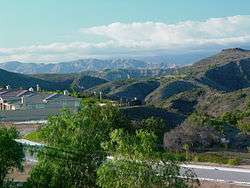
The community contains two major new residential areas, Rancho Conejo Village (built on the site of the former Rancho Conejo Airport, where portions of the film It's a Mad, Mad, Mad, Mad World were filmed[98]) and Dos Vientos Ranch. The first planned community in Newbury Park was Casa Conejo, located in a roughly square-shaped unincorporated area.
Geography
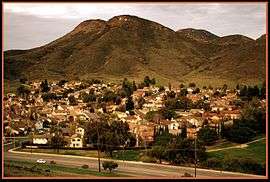
Newbury Park can be described as a town,[6] community,[99] or section[7] mostly within the Thousand Oaks city limits in addition to rural areas west of Thousand Oaks. Newbury Park is bordered by Lynn Road in the east and the Conejo Grade on the west. It borders the Santa Monica Mountains in the south, while Hill Canyon and the ridges of Conejo Canyons Open Space make up its northernmost area. It has an average elevation of 628 ft. (191.4 m.) above sea level, and is situated 12 miles (19.3 km) from the Pacific Ocean. Newbury Park is 42 miles (67.5 km) west of Los Angeles.[3] It is situated in the southeastern corner of Ventura County, between the Santa Monica Mountains to the south, and protected nature areas as Wildwood Regional Park to the north. Thousand Oaks proper is to the east and the city of Camarillo is down the Conejo Grade to the west. Newbury Park is made up of zip code 91320, however, certain post office boxes by Newbury Road use zip code 91319.[3]
Compared to eastern part of Thousand Oaks, Newbury Park remains a significantly more rural community which includes for equestrian areas.[100] The recreational areas accessible from U.S. Highway 101 include the Los Padres and Angeles National Forests. Being located less than six miles from the Los Angeles County line, Newbury Park is in the northwestern part of the Greater Los Angeles Area. Newbury Park is both a benefactor and a victim of the modern-day freeway development. It is a planned community, which originally solely functioned as a commuter bedroom community. In recent times, however, Newbury Park has attracted numerous high-tech industries, keeping many of its former commuters home.[101]
Newbury Park has three freeway exits on U.S. Route 101 (Ventura Freeway). It can also be reached by crossing through the Santa Monica Mountains from the coast. The main road (Potrero Road) through Hidden Valley leads into Newbury Park. There are numerous trailheads including one into the Santa Monica Mountains that leads to the coast. There are also trailheads to Wildwood Regional Park with trails to other portions of Thousand Oaks and Moorpark.
The unincorporated county islands of Casa Conejo, Ventu Park and Kelley Estates are within Newbury Park. Street sign colors varies from unincorporated areas and areas incorporated into Thousand Oaks.[3]
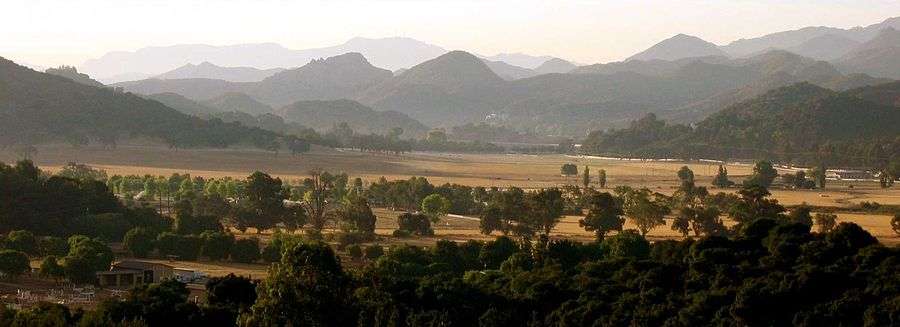
Climate
While the Conejo Valley is generally cooler than the San Fernando and Simi Valleys, the temperature remains temperate year-long in Newbury Park. The region has a mild, year-round Mediterranean climate or Dry-Summer Subtropical zone climate, with warm, sunny, dry summers and cool, rainy winters. Vegetation is typical of Mediterranean environments, with chaparral and grasses on the hillsides and numerous western valley oaks. Its elevation ranges from about 500 to 900 feet (150 to 270 m) (excluding hills). The area has slightly cooler temperatures than the surrounding areas, as it receives cooler air from the ocean through various hill and mountain passes.
Annual rainfall averages about ten inches in Newbury Park, while the humidity averages 52 percent. The temperature ranges from 55 to 77 degrees, and tends to be cooler than in neighboring Thousand Oaks.[3]
| Climate data for Newbury Park, California | |||||||||||||
|---|---|---|---|---|---|---|---|---|---|---|---|---|---|
| Month | Jan | Feb | Mar | Apr | May | Jun | Jul | Aug | Sep | Oct | Nov | Dec | Year |
| Record high °F (°C) | 92 (33) |
92 (33) |
96 (36) |
105 (41) |
102 (39) |
106 (41) |
105 (41) |
105 (41) |
109 (43) |
108 (42) |
99 (37) |
99 (37) |
109 (43) |
| Average high °F (°C) | 68 (20) |
69 (21) |
70 (21) |
74 (23) |
74 (23) |
78 (26) |
81 (26) |
82 (28) |
81 (27) |
78 (26) |
73 (23) |
69 (21) |
74.75 (23.83) |
| Average low °F (°C) | 41 (5) |
42 (6) |
43 (6) |
46 (8) |
49 (9) |
53 (12) |
56 (13) |
57 (14) |
55 (13) |
50 (10) |
44 (7) |
41 (5) |
48.08 (9) |
| Record low °F (°C) | 25 (−4) |
26 (−3) |
25 (−4) |
30 (−1) |
35 (2) |
37 (3) |
42 (6) |
40 (4) |
40 (4) |
32 (0) |
28 (−2) |
25 (−4) |
25 (−4) |
| Average precipitation inches (cm) | 4.18 (10.62) |
4.65 (11.81) |
3.57 (9.07) |
0.80 (2.03) |
0.30 (0.76) |
0.05 (0.13) |
0.01 (0.03) |
0.08 (0.2) |
0.32 (0.81) |
0.52 (1.32) |
1.45 (3.68) |
2.48 (6.3) |
18.41 (46.76) |
| Source: weather.com[102] | |||||||||||||
On March 10 and 11 of 2006, snow fell on the peak of Boney Mountain, the first snow to fall in the area in about 10 years.
Cityscape

The physiography consists of prominent knolls, open vistas, surrounding mountains, and native oak woodland. It is characterized by its many rolling green hills.[99] Businesses are centered on both sides of Ventura Freeway, which bisects the community. A number of businesses can for instance be found on Newbury Road, which is named after Egbert Starr Newbury, the founder of Newbury Park.[103] The industrial area is centered around Rancho Conejo in northern Newbury Park,[104] where corporations such as Amgen, Anthem Blue Cross, DesignworksUSA and Shire (formerly Baxalta) are located. Hotels in Newbury Park include Palm Garden Hotel, La Quinta Inn & Suites, Courtyard by Marriott, and Hampton Inn & Suites. The prominent 2,880 ft. Boney Mountain dominates the Newbury Park horizon from almost any angle.[105]
Newbury Park is bounded by Malibu Coast AVA in the south, home of wineries such as SIP Malibu Grapes, Cornell Winery, and Malibu Family Wines.[106]
Natural hazards
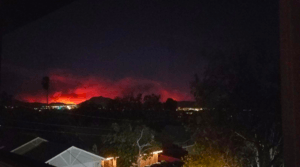
Some of the natural hazards include wildfires,[107][108] earthquakes, heat waves,[109][110] droughts, landslides and erosion.[111][112] The Conejo Valley is relatively often the victim of earthquakes, including the major 1994 Northridge earthquake.[113][114] Along with most of Southern California, droughts are prevalent.[115] The major drought of 1876–1878, with only six inches of rain in thirty months, devastated Newbury Park and forced its founder, Egbert Starr Newbury, to leave the area.[85]
Newbury Park has been affected by the massive Thomas Fire of December 2017, and a smoke advisory was issued by the Ventura County Air Pollution Control District. Subsequently, all public schools were closed on December 6, 2017.[116] An additional 3-acre brush fire, nicknamed the Runner Fire, broke out behind the headquarters of Amgen and Shire (Baxalta) on December 5. Both Amgen and nearby Sage Publishing decided to evacuate their employees due to thick smoke. The fire had a potential of reaching Hill Canyon due to the warm Santa Ana winds, but was contained before causing major damage or injuries.[117]
Geology
Newbury Park is the westernmost community in the Conejo Valley, which is located in southern Ventura County. It is a broad, wide, and high-lying incline, with an average elevation of 900 feet above sea level.[118] It is bordered by the steep ridge-lines of the Santa Monica Mountains to the south and southeast, Conejo Mountains to the west and north (including the Conejo Grade in westernmost Newbury Park), and the Simi Hills to the northeast.[119]
While the Oxnard Plain and the community of Camarillo is immediately to the west, the Santa Rosa Valley is beyond the Conejo Mountains or through Hill Canyon to the north. Beyond the Santa Monica’s to the south is the Pacific Ocean, while the San Fernando Valley is beyond the valley’s eastern ridges. The physiography is characterized by open vistas, high peaks, creeks and creek-beds, prominent knolls, and native oak woodlands.[120]
Along with the Santa Rosa-, Tierra Rejada- and Simi Valleys, the Conejo Valley is also drained by tributaries of the Calleguas Creek. Its principal tributary, Arroyo Conejo, flows through Newbury Park in a southwesterly direction before discharging into the Pacific Ocean by the Mugu Lagoon.[121]

Economy
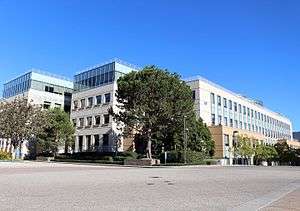
Agriculture was the only industry present in Newbury Park for many decades, and dominated the economy until the 1950s.[122] Today, most of the community is part of the City of Thousand Oaks, whose economy is based on a small range of businesses, with biotechnology, electronics, automotive, aerospace, telecommunications, healthcare, and financing occupying most of Thousand Oaks' employment sector. After the incorporation of large parts of Newbury Park, the City of Thousand Oaks helped revitalize sections of Newbury Park through the former Redevelopment Agency.[123] The global headquarters of biotechnology firm Amgen, DesignworksUSA, as well as the industrial design and styling department of BMW are located in the community, as are offices for Anthem Blue Cross, Sage Publications, and Skyworks Solutions.
Amgen has its headquarters in Newbury Park, and is the world’s largest biotech company as well as the largest employer in the Conejo Valley.[124][125] Founded in 1980, Amgen now employs nearly 7,000, and has attracted hundreds of scientists to the Newbury Park area. Focused on the cutting edge of molecular biology and biochemistry, its goal is to provide a healthcare business based on recombinant DNA technology.[126] Besides Amgen, other major employers include Shire (formerly Baxalta), Baxter Bio Science, Wellpoint Blue Cross, Skyworks Solutions Inc., and many more.[127] Hewlett-Packard was previously located here.[128][129] Particularly during and after the 1960s, the area started to attract large corporations, biotechnology firms, and other high-technology industries. As a result of the steadily increasing number of high-technology industries in the area, Newbury Park has been dubbed “the next Silicon Valley”.[122]
Industry

Northern Newbury Park, which had been land owned by the Janss Corporation since 1916, was zoned industrial and an industrial park started to appear here in 1954. A number of industries soon followed Talley Corporation’s 1954 move to Rancho Conejo, including Packard Bell, Westland Plastics and Technology Institute Corporation in 1960. Westinghouse Corporation moved to Rancho Conejo Industrial Park in 1961, while Northrop Ventura and North American Science Center moved here in 1963. Capitol Records opened its mail order center for all record club memberships in 1968, while Metro-Goldwyn-Mayer (MGM) was planning to build a $30 million movie studio here in the late 1960s.[131][132] Amgen, Anthem Blue Cross, Skyworks Solutions, Sage Publications, DesignworksUSA, Alcoa Fastening Systems & Rings, Spectrum, Condor Pacific Industries, and Shire (formerly Baxalta) are some of the current corporations located in Rancho Conejo.[105] Amazon opened a warehouse here in 2018.[133]
As of 2017, Amgen employs 5,125 people, or 7.5% of Thousand Oaks’ total employment.[134] It is the largest employer in Ventura County.[135][124]
Rancho Conejo Industrial Park contains the majority of Thousand Oaks’ industrial businesses. It has over 120 properties as of 2017, ranging from 5,000 sq. ft. to 127,000 sq. ft.[136]
Culture
Newbury Park is home to museums such as the Stagecoach Inn Museum and the Satwiwa Native American Indian Culture Center. Furthermore, the community is home to the Thousand Oaks Community Gallery and its Thousand Oaks Arts Festival. Other festivals include the annual Spring Art & Crafts Festival, featuring more than one hundred craftspeople and artists,[137] as well as the Newbury Park Jazz Festival which is held annually at the performing arts center at Newbury Park High School. Newbury Park Jazz Festival has presented numerous notable jazz musicians, including Grammy Award-winner Gordon Goodwin, Peter Erskine, John Beasley, Bob Sheppard and Steven Houghton.[138][139]
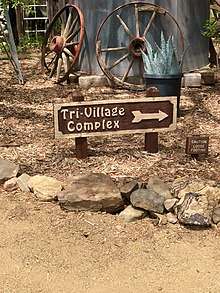

Stagecoach Inn, originally known as Grand Union Hotel, is a city landmark which appears on the National Register of Historic Places. The inn, which originally was erected in 1876, is now operated as a museum. It is home to a replica of the valley’s first school, the Timber School from 1889, as well as a carriage house, blacksmith shop and the “Tri-Village.” Anderson Exhibit Hall showcases Chumash artifacts and fossils found in the area.[140]
Satwiwa Native American Indian Culture Center is located by the Santa Monica Mountains and is operated by the National Park Service. The center is home to a replica of a Chumash house (‘ap), as well as Native-American workshops, programs and art.[141] Satwiwa is located at the foothills of Boney Mountain, a sacred mountain to the Chumash.[142] Satwiwa is used by the Chumash Barbareño-Ventureño Band of Mission Indians for events and ceremonies, including summer solstice and the Hutash ceremony.[63]
Newbury Park Library is a 17,000 sq. ft. (1,600 m2) library which is a regional branch of Grant R. Brimhall Library. The library also houses Thousand Oaks Community Gallery, which hosts visual arts exhibitions, workshops, artist presentations and other events.[143][144][145] It is located immediately across the street from Newbury Gateway Park.
Politics
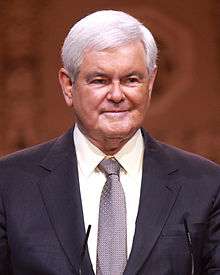
Newbury Park is politically considered to be a stronghold for the Republican Party, and had three registered Republican voters for every Democrat as of 2007.[146][147]
The Calvary Chapel Godspeak in Newbury Park is a church often visited by Republican politicians for speeches and events. Some of the most notable speakers include Republican nominees for president, Rand Paul in 2013[148][149] and Newt Gingrich in 2011.[150]
The senior pastor is Rob McCoy, who was the 2014 Republican candidate for California's 44th State Assembly district and is a current Thousand Oaks' City Council Member.[151][152][153][154]
Republican politician Richard Sybert of Newbury Park has been the Republican candidate for the House of Representatives in 1994 and the 1996, but was defeated both times.[155][156]
Demographics
According to the U.S. Census 2010, 76.81% of the population identify as white, 10.72% Asian-American, 1.88% African-American, 0.09% Native-American, and 6.78% claim 'other'. 19.18% of the people in Newbury Park claim Hispanic ethnicity or heritage. As of 2005, only the community of Newbury Park, not including Thousand Oaks, had a median household income of $83,615.[157] For Thousand Oaks as a whole according to the 2005 US Census Bureau, the median household income was $108,120, while median family income was $110,885.[158] According to Money Magazine, median family income as of 2006 was up to $119,207,[159] which is substantially higher than both the California median income and U.S. median household income of $64,585.[13] The median house value is $678,400.[160]
Public safety
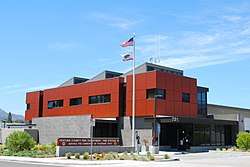
Fire department
The Ventura County Fire Department (VCFD) provides fire protection and emergency medical services. Two fire stations are located in Newbury Park.[162][163]
Law enforcement
Ventura County Sheriff's Office provides law enforcement services for Newbury Park.[164] They operate a resource center in the city.[165]
Crime
Newbury Park has one of the lowest crime rates in California.[164][166] Thousand Oaks has ranked as the 4th-safest city in the United States by The FBI.[167]
It shocked the town when Newbury Park experienced its first homicide in over ten years on November 30, 2017.[168][169]
Education
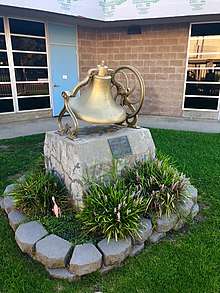
Newbury Park High School has over 2,600 students and a newly refurbished multi-sport stadium. Intermediate schools include Sequoia Middle School and the recently constructed Sycamore Canyon School in Dos Vientos Ranch. All are part of the Conejo Valley Unified School District. [164]
Timber School, now known as Conejo Valley High School, is the first of the existing schools, having been built in 1924 to replace the first one-room schoolhouse that was built in 1889. Recent additions to the school were made in the late 1940s and 1950s. Newbury Park Adventist Academy is the second of the existing schools in Newbury Park, founded in 1947.
- Conejo Valley Unified School District
- Newbury Park High School
- Redwood Middle School
- Sequoia Middle School
- Sycamore Canyon Middle School
- Newbury Park Adventist Academy
- Conejo Adventist Elementary School
- Walnut Elementary School
- Earths Elementary School
- Banyan Elementary School
- Cypress Elementary School
- Maple Elementary School
Media
Thousand Oaks Acorn is the main newspaper serving Newbury Park, while Ventura County Star is a larger regional paper covering the county. Former Newbury Park newspapers have included the Newbury Star by editor Shirley Haigh Sheets (Peggy Page) in the 1960s, as well as Our Town USA and The Newburian, which was published by Newbury Park Adventist Academy with editor Pat Horning. Joseph Canale became the editor of Newbury Park Reporter, after he was sent here in order to establish a Newbury Park edition of the Star Free Press.[172]
Transportation

Newbury Park may be reached from four freeway exits on the Ventura Freeway (U.S. Route 101): Exit 46 for Ventu Park Road, Exit 47A for Rancho Conejo Boulevard, 47B for Borchard Road, and Exit 47B/47C for Wendy Drive. Additionally, the community may be reached on route one (Gold Line) by the Thousand Oaks Transit (TOT), which also serves Thousand Oaks, CA and Westlake Village, CA.[173] Other regional transportation services include Ventura Intercity Service Transit Authority (VISTA) and LADOT Commuter Express.[174] While LADOT connects to communities in Los Angeles County, VCTC Intercity offers transits from Newbury Park to coastal cities such as Ventura and Oxnard. Although there are no railway stations in Greater Thousand Oaks, TOT offers daily transfers to Moorpark Metrolink Station.[175]
Newbury Park was home to Rancho Conejo Airport which opened in May 1960 and closed around 1965. The airport was described in the Los Angeles Times as "the finest executive aircraft facility on the West Coast... and will serve the needs of the fast-moving executives of the space-age industries." It was located next to the Rancho Conejo industrial property, northwest of the intersection of North Ventu Park Road and Lawrence Drive. It was near the mouth of Hill Canyon, immediately west of Lynn Ranch.[176][177]
Notable people
The community is home to celebrities. Examples include swing bandleader and clarinet player Artie Shaw lived in Newbury Park from 1978 until his death in 2004. Comic book author Jack Kirby lived in Newbury Park for at least his last two decades. Carah Faye Charnow of the band Shiny Toy Guns resides in town. The band The Neighbourhood, M. Ward of She & Him, and Belinda Carlisle from The Go-Go's all grew up in Newbury Park. Jordan Cameron played football for Newbury Park High School and went on to be drafted to the NFL by the Cleveland Browns then as a tight end for the Miami Dolphins. Others include Amanda Bynes who went to La Reina High School, Colbie Caillat, Brandon Mull, and Heather Locklear.[178] Football player Jamon Brown of the Los Angeles Rams resides in Dos Vientos in western Newbury Park.[179][180] Football player Colby Cameron is from Newbury Park, while evangelist George Vandeman lived in the community at the time of his death in 2000.[181] Other notable residents include Joe Conley, Craig Saavedra, Andrew Lambo, Will Svitek, Wayne Hooper, Donny Atherton and Marian Mercer.
In popular culture
Because of its relatively close proximity to the studios in Hollywood, numerous TV shows and movies were filmed here, including for example Flaming Frontier (1926), Wild Horse (1931), Clearing the Range (1931), Wuthering Heights (1939), Lassie Come Home (1943), Sands of Iwo Jima (1949),[186] The Horse Soldiers (1959), and It's a Mad, Mad, Mad, Mad World (1963).[187][188] More recent movies filmed here includes Bedtime Stories (2008), Gamers: The Movie (2006), Road to the Open (2014), The Diner (2014), and The Double Born (2008).[189]
Various movies have also been shot in Hidden Valley, which borders the Santa Monica Mountains in southernmost Newbury Park. Some movies shot here include Alvin and the Chipmunks (2007), Commando (1985), The Lone Ranger (1956), Come On, Tarzan (1932), Jagged Edge (1985), The Hand (1981), Spinout (1965), Three Hours to Kill (1954), A Lawless Street (1955), and many more. TV-series with shots filmed here include American Horror Story (2011), Justified (2010), Beverly Hills, 90210 (1992), Columbo (1971), Charmed (1988), amongst others.[190]
Many western-style movies were filmed in Wildwood Regional Park, which borders Newbury Park to the north. Some of the movies and TV-series filmed here include Bonanza, Dodge City, Gunsmoke, The Rifleman, Flaming Star, The Big Valley and Wagon Train, as well as films such as Spartacus, Gunsight Ridge, The Grapes of Wrath, and Duel in the Sun.[191]
Belinda Carlisle was a student at Newbury Park High School, and has credited her song California to her life "growing up in Newbury Park and Southern California."[192][193]
Recreation
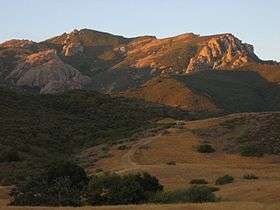
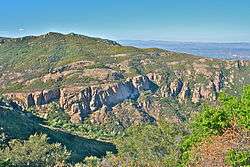
Newbury Park offers miles of trails and a natural environment integrated among its neighborhoods.[194] It borders the Boney Mountains State Wilderness Area and the Santa Monica Mountains to the south, the Los Robles Open Space Area to the east, and the Arroyo Conejo Open Space Area and Wildwood Regional Park to the north. In addition to the aforementioned nature areas, the Potrero Open Space is located entirely within the town, while the Hope Nature Reserve is partly in eastern Newbury Park. There are numerous hiking trails nearby, including the Rancho Potrero Open Space Area which connects to trails leading to the Pacific Ocean through the Rancho Sierra Vista Park, the Santa Monica Mountains National Recreation Area and Point Mugu State Park.[195] Rancho Sierra Vista is a National Recreation Area in Newbury Park’s southern edge and is administrated by the U.S. National Park Service.[196] With more than a hundred miles of trails in the Santa Monica Mountains, the Rancho Sierra Vista in southern Newbury Park is a popular nature area for hiking, mountain biking, camping, horseback-riding, and other recreational activities.[197] While the Backbone Trail leads to Will Rogers State Beach in the Los Angeles neighborhood of Pacific Palisades, Sandstone Peak is the highest mountain in the Santa Monica Mountains and another popular hiking destination. The peak provides views of the Pacific Ocean, Malibu, Santa Monica, Conejo Valley, and numerous Channel Islands. The Conejo Mountain Edison Road Trail, commonly known as the Powerline Trail, is located in the Dos Vientos Open Space Area and provides panoramic views of the cities of Camarillo and Oxnard.
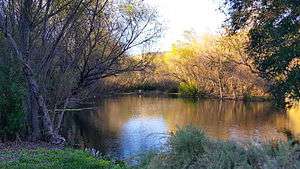
On the northern end is Wildwood Regional Park, which offers fourteen trails covering more than 17 miles (27 km).[200] Wildwood is recognized as a natural attraction and a contributing factor to Ventura County being ranked the most desirable U.S. county to live in by the Washington Post in 2015.[201] The regional park comprises 1,732 acres (7.01 km2) and borders 1,397 acres (5.65 km2) of open space.[202] It is accessible from northern Newbury Park and is located within the Thousand Oaks city limits. While Wildwood provides trails to the cities of Thousand Oaks and Moorpark, the Los Robles Trail is a 25-mile (40 km) contiguous route to Westlake Village.[203] Point Mugu is accessible through the Rancho Sierra Vista/Satwiwa in the Santa Monica Mountains to the south. The Santa Monica Mountains National Recreation Area comprises more than 63,000 acres (250 km2) of natural open-space area, where approximately 928 acres are located within the town’s southern edge.[202]
Two campgrounds, Danielson and Circle X, are reached from Potrero Road in Newbury Park.[204]
List of parks and public open-space
List of public-owned open-space areas and parks in Newbury Park:[202][205]
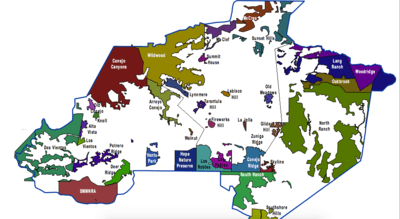

- Alta Vista Open Space
- Arroyo Conejo Open Space
- Banyan Park
- Borchard Community Park
- Conejo Canyons Open Space
- Cypress Park
- Deer Ridge Open Space
- Del Prado Playfield
- Dos Vientos Community Park
- Dos Vientos Open Space
- Dos Vientos Neighborhood Park
- Hickory Park
- Kimber Park
- Knoll Open Space (Knoll Park)
- Los Vientos Open Space
- Lynn Oaks Park
- Newbury Gateway Park
- Old Conejo Open Space
- Peppertree Playfield
- Potrero Ridge Open Space
- Rancho Conejo Playfields
- Rancho Sierra Vista Park (Satwiwa)
- Santa Monica Mountains National Recreation Area (SMMNRA)
- Stagecoach Inn Park
- Ventu Park Open Space
- Walnut Grove Park
- Walnut Open Space
- Wendy Park

Wildlife
Being surrounded by open-space wilderness areas and wildlife corridors to both the south and north, the town is home to an abundance of wildlife. Compared to neighboring City of Thousand Oaks, which consists of nearly 50% developed area, Newbury Park remains a significantly more rural community than its counterpart to the east.[120] Approximately 928 of the 63,000 acres compromising the Santa Monica Mountains National Recreation Area is located within Newbury Park.[211] It is recognized as the largest urban national park in the United States and is a California wildlife preserve.[212] Rancho Sierra Vista in southern Newbury Park is one of the primary park units and functions as a crucial Southern California wildlife-corridor.[213] Wildlife in the southern edge of town is therefore incredibly abundant, and includes animals such as black bears, eagles, porcupines, deer, prairie wolves, rabbits, falcons, bobcats, foxes, hawks, and more.[214][215]
The National Park Service estimates a population of 10–15 Mountain lions inhabiting the Santa Monica Mountains as of 2015,[216] in addition to mountain lions living permanently in Wildwood Regional Park which borders the town to the north.[217][218] As a result of bordering numerous wilderness areas, there are few dangers presented for the mountain lion, which is consequentially not a threatened species in the area.[219] Because of their large habitat and few dangers, lions are relatively often creating a hazard in suburban areas of Newbury Park.[206][220][221] The mountain lion is not the only mammal threatening both inhabitants and their pets,[222] but outdoor dogs and cats are often prey for an increasing number of coyotes, bobcats, and owls.[223][224] An increasing number of snake species in suburban areas have also recently been recorded and poses a threat to people and pets as well.[225] Other animals posing potential danger includes venomous spiders[219] and scorpions, most notably the Stripe-tailed scorpion.[226]
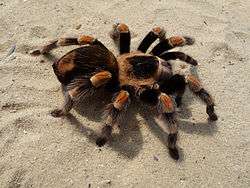
Mammals more frequently encountered than the Mountain lion include the Valley coyote, Bobcat, Mule deer, Gray fox, Desert cottontail, Virginia opossum, California raccoon, Long-tailed weasel, American badger and the Striped skunk. Other species of mammals include the Ring-tailed cat, Spotted skunk, Botta's pocket gopher, Brush rabbit, Broad-footed mole, California vole, Ornate shrew, and three species of squirrel: the California ground squirrel, Western gray squirrel, and Fox squirrel. Mice and rats include the California pocket mouse, House mouse, Western harvest mouse, Deer Mouse, Agile kangaroo rat, Pack rat, Dusky-footed woodrat, and the Brown- and Black rat. There are eleven recorded species of bats.[120] Amphibians include the Blackbelly salamander, Ensatina, Western skink, and numerous toad- and frog species: California toad, American bullfrog, California treefrog and Pacific treefrog.
The Western pond turtle is an endemic species to the Arroyo Conejo and other creeks. Newbury Park is home to an abundance of reptiles, including lizards such as the Western fence lizard, Coast horned lizard, Common side-blotched lizard, Southern alligator lizard, Teiidae and the California legless lizard. There are eleven species of snake recorded in the Greater Thousand Oaks Area: Southern Pacific rattlesnake, Ring-necked snake, Western yellowbelly racer, California whipsnake, Coachwhip, Gopher snake, California kingsnake, Two-striped garter snake, Western Black-headed Snake, Lyre snake, and Night snake. Thousand Oaks proper is home to 171 recorded species of birds, including seventeen raptors such as the Barn owl, Cooper’s hawk, American kestrel, Prairie falcon, Red-shouldered hawk, Golden eagle, Great horned owl, White-tailed kite, California vulture, Northern harrier, Sharp-shinned hawk, Ferruginous hawk, Merlin and Screech owl. Commonly encountered bird species include the House sparrow, House finch, Brewer's blackbird, Common raven, California towhee, Acorn woodpecker, California quail, and the Red-tailed hawk.[120]
Points of interest
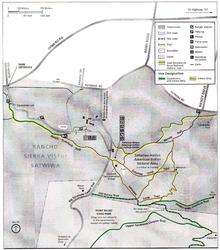
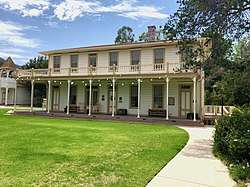
Places of interest include:[228][229]
- Boney Mountains State Wilderness Area, areas of Santa Monica Mountains surrounding Mount Boney
- Hope Nature Preserve, nature preserve and gift from actor Bob Hope
- Newbury Park High School Theatre, host of the annual Newbury Park Jazz Festival and other festivals, plays and musicals.[230]
- Newbury Park Library, branch of Grant R. Brimhall Library, home of Thousand Oaks Community Gallery.[143]
- Point Mugu State Park, 14,000-acre California State Park offering 60 miles of hiking trails.[231]
- Backbone Trail, long-distance trail connecting Newbury Park to the Pacific Ocean
- Big Sycamore Canyon, canyon in Point Mugu State Park which cuts through the Santa Monica Mountains. The upper Sycamore Canyon is reached via Potrero Road in Newbury Park.[204]
- Sycamore Canyon Falls ("Rancho Sierra Vista Falls"), 70-foot layered waterfall with series of cascades in Point Mugu State Park. Easiest accessed from Satwiwa with parking at the intersection of Wendy Dr. and Potrero Rd.[232][233][234]
- Rosewood Trail, hiking trail to the 1,603 feet Angel Vista in the Santa Monica's
- Santa Monica Mountains National Recreation Area (SMMNRA), part of Santa Monica Mountains managed by the U.S. National Park Service. It is the world's largest urban national park.[235][236][237][238]
- Satwiwa Native American Indian Culture Center, Native-American museum at the foothills of Boney Mountain, a sacred mountain to the Chumash Indians.
- Rancho Sierra Vista, historic ranch area owned by the National Park Service. "Big Sycamore to the Sea" is a relatively easy 8-mile hike from Rancho Sierra Vista to the ocean via Point Mugu State Park.[239]
- Stagecoach Inn, 1876 stagecoach hotel now operating as a museum. On the U.S. National Register of Historic Places. Designated California Historical Landmark #659, Ventura County Landmark #30, and Thousand Oaks City Landmark No. 1.[240][241]
- Timber School, oldest school structure still standing in Conejo Valley. Thousand Oaks City Landmark #12 and Ventura County Landmark No. 166.[244][245]
- Wildwood Regional Park, 1,765 acre regional park bordering Newbury Park in the north

See also

- Timber School
References
- 1 2 U.S. Geological Survey Geographic Names Information System: Newbury Park
- ↑ "Child Care Needs Assessment" (PDF). Local Planning Council of Ventura County. December 2010. p. 23. Retrieved 2015-10-06.
- 1 2 3 4 5 6 Needham, Beth (1990). Newbury Park. Thousand Oaks, CA: Beth Needham. Page 1.
- ↑ Snyder, Tom (2014). Pacific Coast Highway: Traveler's Guide. St. Martin's Griffin. Page 153. ISBN 9781466868342.
- ↑ Dr. Raza, Moonis (1990). Geographical Dictionary of the World. Concept Publishing Company. Page 1279. ISBN 9788172680121.
- 1 2 Real Estate Communications, Inc. (1984). California Real Estate Directory. Page 201.
- 1 2 Bustillo, Miguel (June 17, 1996). "Sparks Could Fly at Town Meeting". Los Angeles Times. Retrieved 2015-06-03.
- ↑ "Tell Me a Little Bit About Newbury Park".
- ↑ Wolowicz, Daniel (January 26, 2006). "Thousand Oaks a safe city but gangs still a problem". Thousand Oaks Acorn. Archived from the original on December 30, 2015. Retrieved October 6, 2015.
- ↑ "About the City". City of Thousand Oaks. Archived from the original on 2015-10-06. Retrieved 2015-10-06.
- ↑ "Newbury Park full of culture" (PDF). CMA Real Estate Networking Group. September 28, 2009. Retrieved 2015-10-06.
- ↑ "Newbury Park neighborhood in Newbury Park, California (CA), 91320, 91360, 93012 subdivision profile – real estate, apartments, condos, homes, community, population, jobs, income, streets". city-data.com. Retrieved 2016-02-10.
- 1 2 "Newbury Park (zip 91320), California". Sperling's Best Places. Retrieved 2015-10-06.
- ↑ http://articles.latimes.com/1992-05-26/local/me-178_1_high-school-teacher
- ↑ Brant, Cherie (2006). Keys to the County: Touring Historic Ventura County. Ventura County Museum. Page 135. ISBN 978-0972936149.
- ↑ Bidwell, Carol A. (1989). The Conejo Valley: Old and New Frontiers. Windsor Publications. Page 32. ISBN 9780897812993.
- ↑ "Egbert Starr Newbury" (PDF). Artlex.com\Accessdate=2016-02-24. Archived from the original (PDF) on 2016-02-23. Retrieved 2016-02-15.
- ↑ Begun, Ruthanne (2006). The Newburys of Newbury Park. Conejo Valley Historical Society. Page 22. ISBN 9780972523332.
- ↑ "Newbury Park Limo Service". Blackhawklimo.com. Retrieved 2016-02-24.
- ↑ Maulhardt, Jeffrey Wayne (2010). Conejo Valley. Arcadia Publishing. Page 119. ISBN 9780738580395.
- ↑ Bitong, Anna (2013-02-14). "Newbury Park station has long history of moves | Thousand Oaks Acorn". M.toacorn.com. Archived from the original on 2016-03-12. Retrieved 2016-02-24.
- 1 2 Sprankling, Miriam and Ruthanne Begun (2012). Tales and Voices of the Conejo. Newbury Park, CA: Conejo Valley Historical Society. Page 97. ISBN 0-9725233-6-7.
- ↑ "Newbury Family". Stagecoachmuseum.org. Archived from the original on 2016-03-04. Retrieved 2016-02-24.
- 1 2 Durham, David (2000). Durham's Place Names of Greater Los Angeles. Quill Driver Books. p. 119. ISBN 1-884995-28-4.
- 1 2 Choate, Gretchen Luther (1973). Directory of California independent Schools. Western Area Bureau of Information. p. 234.
- 1 2 "Tell Me a Little Bit About Newbury Park — Conejo Valley Guide". Conejovalleyguide.com. 2015-06-30. Retrieved 2016-02-24.
- ↑ Begun, Ruthanne (2006). The Newburys of Newbury Park. Conejo Valley Historical Society. Pages 7 and 40. ISBN 9780972523332.
- ↑ Sprankling, Miriam (2002). Discovering the Story of The Conejo Valley. Newbury Park, CA: Conejo Valley Historical Society. Page 29. ISBN 0-9725233-0-8.
- ↑ Begun, Miriam and Ruthanne Sprankling (2009). Ladies of The Conejo. Conejo Valley Historical Society. Page 18. ISBN 9780972523356.
- ↑ "Santa Monica Mountains National Recreation Area" (PDF). National Parks Conservation Association. pp. 75–76. Archived from the original (PDF) on 2015-10-06. Retrieved 2015-10-06.
- ↑ Sanger, Tom; Sanger, Kay (March 10, 1990). "Museums, Festivals, Classes Open Door to Learning Indian History". Los Angeles Times. Retrieved 2015-10-06.
- 1 2 Maxwell, Thomas J. (2000). Hiking In Wildwood Regional Park: Natural History, Folklore, and Trail Guide. California Lutheran University (CLU). Page 77.
- ↑ Maxwell, Thomas J. (1982). The Temescals of Arroyo Conejo. California Lutheran College. Page 9. Library of Congress Catalog Number 82-072788.
- ↑ Maxwell, Thomas J. (1982). The Temescals of Arroyo Conejo. California Lutheran College. Pages 5–9. Library of Congress Catalog Number 82-072788.
- ↑ Maxwell, Thomas J. (1982). The Temescals of Arroyo Conejo. California Lutheran College. Page 5. Library of Congress Catalog Number 82-072788.
- ↑ McTigue, Mickey (1993). Mountain Biking the Coast Range: Ventura County & the Sespe Guide 4. Fine Edge Publications. Page 17. ISBN 9780938665182.
- ↑ Brundige, Don and Sharron (1994). Bicycle Rides: Santa Barbara and Ventura Counties. B-D Enterprises. Page 220. ISBN 9780961915162.
- ↑ Begun, Ruthanne and Miriam Sprankling (2004). A Visit to the Historic Stagecoach Inn Museum. Newbury Park, CA: Conejo Valley Historical Society. Page 9. ISBN 0-9725233-2-4.
- ↑ Tennesen, Michael (2007). Santa Monica Mountains National Recreation Area. Western National Parks Association. Pages 13–14. ISBN 9781583690697.
- ↑ Bidwell, Carol A. (1989). The Conejo Valley: Old and New Frontiers. Windsor Publications. Page 13. ISBN 9780897812993.
- ↑ Bidwell, Carol A. (1989). The Conejo Valley : Old and New Frontiers. Windsor Publications. Page 13. ISBN 9780897812993.
- ↑ Casey, Lynda (1984). The Story of the Conejo Valley: The Westlake Chumash Indians. Westlake Research Committee. Page 5.
- ↑ "Archived copy" (PDF). Archived from the original (PDF) on 2017-02-12. Retrieved 2016-02-25.
- ↑ "Historic Resources Report and Peer Review" (PDF). Camarillo-smart-growth.org. Retrieved 8 May 2018.
- ↑ Chester, King, (1 December 1975). "The Names and Locations of Historic Chumash Villages". The Journal of California Anthropology. 2 (2). Retrieved 8 May 2018.
- ↑ Maxwell, Thomas J. (1982). The Temescals of Arroyo Conejo. California Lutheran College. Page 93. Library of Congress Catalog Number 82-072788.
- ↑ "Map and Site Information: Rancho Sierra Vista/ Satwiwa – Santa Monica Mountains National Recreation Area (U.S. National Park Service)". Nps.gov. 2015-01-05. Retrieved 2016-02-24.
- ↑ Straus, Naomi (2004). Let's Go California 10th Edition. Macmillan. p. 474, ISBN 9780312335441.
- ↑ "Data". Archived from the original on 2016-02-22. Retrieved 2016-02-11.
- ↑ Stienstra, Tom and Ann Marie Brown (2012). Moon California Hiking: The Complete Guide to 1,000 of the Best Hikes in the Golden State. Avalon Travel. Page 711. ISBN 9781612381633.
- ↑ Lightfoot, Kent G. and Otis Parrish (2009). California Indians and Their Environment: An Introduction. Page 258. University of California Press. ISBN 9780520244719.
- ↑ Eargle, Dolan H. (1992). California Indian Country: The Land & The People. Trees Company Press. Page 122. ISBN 9780937401200.
- ↑ Maxwell, Thomas J. (1982). The Temescals of Arroyo Conejo. California Lutheran College. Page 137. Library of Congress Catalog Number 82-072788.
- ↑ JOHN McKINNEY (1998-11-08). "A Walk in the Footsteps and Folkways of the Chumash – latimes". Articles.latimes.com. Retrieved 2016-02-24.
- ↑ Maxwell, Thomas J. (1982). The Temescals of Arroyo Conejo. California Lutheran College. Pages 78. Library of Congress Catalog Number 82-072788.
- ↑ Ciolek-Torrello, Richard (2006). A Passage in Time: The Archaeology and History of the Santa Susana Pass State Historical Park, California. Statistical Research. Page 42. ISBN 9781879442894.
- ↑ Whitley, David S. and Ellen L. McCann (1980). Inland Chumash Archaeological Investigations. Institute of Archaeology. Pages 155 and 255.
- ↑ "Chumash Exhibit". Stagecoachmuseum.org. Archived from the original on 2016-03-02. Retrieved 2016-02-24.
- ↑ "Satwiwa Ranch House in Newbury Park Honors Chumash Lore and Land – latimes". Articles.latimes.com. 1987-10-22. Retrieved 2016-02-24.
- ↑ "Satwiwa Native American Indian Culture Center – Santa Monica Mountains National Recreation Area (U.S. National Park Service)". Nps.gov. 2015-01-05. Retrieved 2016-02-24.
- ↑ July 30, 2004 (2004-07-30). "Chumash influence lingers". Vcstar.com. Retrieved 2016-02-24.
- ↑ Kennedy, Frances H. (2008). American Indian Places: A Historical Guidebook. Houghton Mifflin Harcourt. Page 243. ISBN 9780547523675.
- 1 2 KATE POSS (1991-06-19). "NEWBURY PARK : Chumash Event to Greet Solstice". Los Angeles Times. Retrieved 2016-02-24.
- ↑ Schroeder, Anne (2000). Branches on the Conejo: Leaving the Soil After Five Generations. Russell Dean & Company, pg. 121; ISBN 9781891954993
- ↑ "John Edwards". Stagecoach Inn Museum. Archived from the original on 2007-02-22. Retrieved 2015-10-06.
- ↑ "Conejo School". Stagecoach Inn Museum. Archived from the original on 2015-12-18. Retrieved 2015-10-06.
- ↑ "Newbury Family". Stagecoach Inn Museum. Archived from the original on 2015-12-18. Retrieved 2015-10-06.
- ↑ Pryor, Alton (2014). The Mexican Land Grants of California. CreateSpace Independent Publishing Platform. ISBN 9781494949181.
- ↑ Maulhardt, Jeffrey Wayne (2010). Conejo Valley (Images of America). Arcadia Publishing, pg. 13; ISBN 9780738580395
- 1 2 Begun, Ruthanne and Miriam Sprankling (2004). A Visit to the Historic Stagecoach Inn Museum. Newbury Park, CA: Conejo Valley Historical Society. Page 9. ISBN 0-9725233-2-4.
- ↑ Capace, Nancy (1999). Encyclopedia of California. North American Book Dist LLC, pg. 350; ISBN 9780403093182
- ↑ Begun, Ruthanne (2006). The Newburys of Newbury Park. Conejo Valley Historical Society. Page 7. ISBN 9780972523332.
- 1 2 Begun, Ruthanne (2006). The Newburys of Newbury Park. Conejo Valley Historical Society. Page 40. ISBN 9780972523332.
- ↑ Begun, Ruthanne (2006). The Newburys of Newbury Park. Conejo Valley Historical Society. Page 37. ISBN 9780972523332.
- ↑ Begun, Ruthanne (2006). The Newburys of Newbury Park. Conejo Valley Historical Society, pp. 38–39; ISBN 9780972523332
- ↑ Begun, Ruthanne (2006). The Newburys of Newbury Park. Conejo Valley Historical Society, pg. 42; ISBN 9780972523332
- ↑ Schroeder, Anne (2000). Branches on the Conejo: Leaving the Soil After Five Generations. Russell Dean & Company. Page 25. ISBN 9781891954993.
- ↑ Begun, Ruthanne (2006). The Newburys of Newbury Park. Conejo Valley Historical Society, pg. 46; ISBN 9780972523332
- ↑ Bidwell, Carol A. (1989). The Conejo Valley: Old and New Frontiers. Windsor Publications, pg. 26; ISBN 9780897812993
- ↑ Schroeder, Anne (2000). Branches on the Conejo: Leaving the Soil After Five Generations. Russell Dean & Company, pp. 85-86; ISBN 9781891954993
- ↑ https://www.toacorn.com/articles/newbury-park-station-has-long-history-of-moves/
- ↑ O’Brien, Tricia (2017). Thousand Oaks and Westlake Village (Images of America). Arcadia Publishing. Page 9. ISBN 9781439661956.
- ↑ Begun, Ruthanne (2006). The Newburys of Newbury Park. Conejo Valley Historical Society, pg 41; ISBN 9780972523332
- ↑ Begun, Ruthanne (2006). The Newburys of Newbury Park. Conejo Valley Historical Society, pg. 48; ISBN 9780972523332
- 1 2 Begun, Ruthanne (2006). The Newburys of Newbury Park. Conejo Valley Historical Society, pp. 49–50; ISBN 9780972523332
- ↑ "Casa Conejo resident hopes to foster sense of community with signs". vcstar.com. Retrieved 2016-02-10.
- 1 2 3 Schroeder, Anne (2000). Branches on the Conejo: Leaving the Soil After Five Generations. Russell Dean & Company, pg. 86; ISBN 9781891954993
- ↑ McCormack, Don (2000). Santa Barbara and Ventura 2001. Mccormacks Guides, pg. 116; ISBN 9781929365203
- 1 2 Bidwell, Carol A. (1989). The Conejo Valley: Old and New Frontiers. Windsor Publications, pg. 54; ISBN 9780897812993
- ↑ Begun, Miriam and Ruthanne Sprankling (2009). Ladies of The Conejo. Conejo Valley Historical Society, pp. 93–94; ISBN 9780972523356
- ↑ "11th Amgen Tour of California Returns to Thousand Oaks at Stage 3 on May 17, 2016".
- ↑ "Forty-Seven Things to Do In Thousand Oaks". conejovalleyguide.com. Retrieved 2017-12-18.
- ↑ Hauf, Tim (2001). Ventura County: A Photographic Perspective. Tim Hauf Photography, pg. 48; ISBN 9780965968874.
- ↑ "President Bush Visits Newbury Park". nphs.org. Retrieved 2017-12-18.
- ↑ Spada, James (2004). The Bush Family: Four Generations of History in Photographs. Macmillan, pg. 218; ISBN 9780312335144
- ↑ "The Acorn | Serving Agoura Hills, Calabasas, Oak Park & Westlake Village". theacorn.com. Archived from the original on 2017-07-05. Retrieved 2017-12-18.
- ↑ "Presidential visit to Santa Monica Mountains creates controversy". malibutimes.com. Retrieved 2017-12-18.
- ↑ Freeman, Paul. "History of Rancho Conejo Airport". Retrieved 2015-10-06.
- 1 2 Strong, Kathy (2011). Southern California Off the Beaten Path: A Guide to Unique Places. Rowman & Littlefield. Page 42. ISBN 9780762774784.
- ↑ BUSTILLO, MIGUEL (1990-05-27). "Sparks Could Fly at Town Meeting". Los Angeles Times. Retrieved 2016-02-24.
- ↑ Snyder, Tom (2014). Pacific Coast Highway: Traveler's Guide. St. Martin's Griffin. p. 153. ISBN 9781466868342.
- ↑ "Average Weather for Newbury Park, CA – Temperature and Precipitation:". Archived from the original on 2011-05-12. Retrieved 2007-12-23.
- ↑ Begun, Miriam and Ruthanne Sprankling (2009). Ladies of The Conejo. Conejo Valley Historical Society. Page 133. ISBN 9780972523356.
- ↑ "Industrial building brings in record haul - Thousand Oaks Acorn". Toacorn.com. 26 April 2018. Retrieved 8 May 2018.
- 1 2 https://www.vcreporter.com/2016/02/1050-2/
- ↑ http://www.latimes.com/food/dailydish/la-dd-malibu-coast-vintners-recognized-with-new-ava-20140721-story.html
- ↑ "Residential evacuations ordered in new Southern California wildfire". CNN. Retrieved 2017-12-18.
- ↑ "Looters Target Evacuated Home In Newbury Park During Camarillo Springs Wildfire (VIDEO) | HuffPost". huffingtonpost.com. Retrieved 2017-12-18.
- ↑ "Repair Specialists Report Increase In AC Breakdowns During Heat Wave « CBS Los Angeles". losangeles.cbslocal.com. Retrieved 2017-12-18.
- ↑ "Record-breaking heat wave expected to continue through Thursday". vcstar.com. Retrieved 2017-12-18.
- ↑ California, State of. "CGS Information Warehouse" (PDF). gmw.consrv.ca.gov.
- ↑ "Landslide Wipes Out Ventura Apartments - Page 3". latimes. Retrieved 2017-12-18.
- ↑ Bolin, Robert and Lois Stanford (2006). The Northridge Earthquake: Vulnerability and Disaster. Routledge. Page 154. ISBN 9781134682331.
- ↑ "Earthquake Rumbles in Malibu, Thousand Oaks - NBC Southern California". nbclosangeles.com. Retrieved 2017-12-18.
- ↑ "Drought surcharge could mean higher water bills in Newbury Park". vcstar.com. Retrieved 2017-12-18.
- ↑ "Caught in the middle | Thousand Oaks Acorn". toacorn.com. Retrieved 2017-12-18.
- ↑ "Amgen, Sage evacuated as fires rage around Thousand Oaks | Thousand Oaks Acorn". toacorn.com. Retrieved 2017-12-18.
- ↑ "Grow Your Business: Ventura County" (PDF). Cotyofventura.net. Archived from the original (PDF) on 2012-06-10. Retrieved 2016-02-24.
- ↑ "Preliminary Geologic Map of the Thousand Oaks 7.5' Quadrangle, Southern California: A Digital Database". Pubs.usgs.gov. Retrieved 2016-02-24.
- 1 2 3 4 "Thousand Oaks – Conservation Element". Toaks.org. 1996-07-02. Archived from the original on 2016-01-21. Retrieved 2016-02-24.
- ↑ Edwards, Ronald D. (1970). Soil survey, Ventura area, California. U.S. Soil Conservation Service, pg. 142.
- 1 2 Bidwell, Carol A. (1989). The Conejo Valley: Old and New Frontiers. Windsor Publications. Page 111. ISBN 9780897812993.
- ↑ Bidwell, Carol A. (1989). The Conejo Valley: Old and New Frontiers. Windsor Publications. Page 159. ISBN 9780897812993.
- 1 2 Baker, Pam (2002). Thousand Oaks Westlake Village: A Contemporary Portrait. Community Communications, Inc. Page 37. ISBN 978-1581920611.
- ↑ "Archive". toaks.org. Archived from the original on 2016-01-21. Retrieved 2017-12-18.
- ↑ Bidwell, Carol A. (1989). The Conejo Valley: Old and New Frontiers. Windsor Publications. Pages 128–129. ISBN 9780897812993.
- ↑ "Conejo Valley - The Conejo Valley's Largest Employers". conejovalley.com. Retrieved 2017-12-18.
- ↑ Chalquist, Craig (2008). Deep California: Images and Ironies of Cross and Sword on El Camino Real. Craig Chalquist. Page 279. ISBN 9780595514625.
- ↑ Allen, Patricia A. (1978). Janss: A Brief History. Janss Recognition Committee. Page 18.
- ↑ Jacobus, John L. (2013). The Fisher Body Craftsman’s Guild: An Illustrated History. McFarland. Page 180. ISBN 9780786493388.
- ↑ Needham, Beth (1990). Newbury Park. Thousand Oaks, CA: Beth Needham. Page 14.
- ↑ O’Brien, Tricia (2017). Thousand Oaks and Westlake Village (Images of America). Arcadia Publishing. Page 8. ISBN 9781439661956.
- ↑ https://www.toacorn.com/articles/amazon-leases-space-in-rancho-conejo/
- ↑ http://www.toaks.org/home/showdocument?id=17130 (Page 162)
- ↑ https://www.mpacorn.com/articles/biotech-giant-amgen-has-big-plans-for-new-plant/
- ↑ http://www.toaks.org/home/showdocument?id=16994 (Page 32)
- ↑ "Conejo Recreation and Park District – Spring Art & Crafts Festival". Crpd.org. Retrieved 2016-02-24.
- ↑ "NEWBURY PARK JAZZ FESTIVAL : Flyer" (PDF). Pvsd.k12.ca.us. Retrieved 8 May 2018.
- ↑ "10th Annual Newbury Park High School Jazz Festival on Saturday, March 17, 2018". Conejovalleyguide.com. Retrieved 8 May 2018.
- ↑ "Permanent". Stagecoach Inn Museum. Retrieved 8 May 2018.
- ↑ "Satwiwa Native American Indian Culture Center in Newbury Park". Conejovalleyguide.com. Retrieved 8 May 2018.
- ↑ SANGER, TOM; SANGER, KAY (10 March 1990). "Museums, Festivals, Classes Open Door to Learning Indian History". Articles.latimes.com. Retrieved 8 May 2018 – via LA Times.
- 1 2 "Library - Thousand Oaks, CA". Toaks.org.
- ↑ "Thousand Oaks Art Gallery: GALLERY". Toartgallery.org.
- ↑ "Thousand Oaks Community Art Gallery - Thousand Oaks, CA". Tolibrary.org.
- ↑ Here Publishing (2004). The Advocate No. 917, Jun. 22, 2004. Page 43. ISSN 0001-8996.
- ↑ Congressional Quarterly Inc. (2007). Congressional Districts: A Portrait of America, pg. 93; ISBN 9780871877222
- ↑ Greene, Sean (2013-06-07). "Rand Paul takes aim at 'moral depravity'". Simi Valley Acorn. Archived from the original on 2016-02-24. Retrieved 2016-02-24.
- ↑ Greene, Sean (2013-06-06). "Rand Paul calls for spiritual revival". Toacorn.com. Archived from the original on 2016-03-12. Retrieved 2016-02-24.
- ↑ Bitong, Anna (2011-09-15). "Republican primary candidate Newt Gingrich addresses Calvary Chapel in Newbury Park". The Acorn. Archived from the original on 2016-02-24. Retrieved 2016-02-24.
- ↑ "Thousand Oaks, CA: City Council". Toaks.org. Retrieved 2016-12-21.
- ↑ Bitong, Anna (2015-02-05). "Potential candidates emerge with filing period days away". Toacorn.com. Archived from the original on 2016-03-12. Retrieved 2016-02-24.
- ↑ "David Lane's American Renewal Project mobilizing pastors to run for office". The Washington Times. Retrieved 2016-02-24.
- ↑ "Republican Rob McCoy concedes Ventura County Assembly race". LA Times. 2014-11-05. Retrieved 2016-02-24.
- ↑ "LOS ANGELES: Bank Adviser Enters GOP Contest to Face Beilenson – latimes". Articles.latimes.com. 1993-11-30. Retrieved 2016-02-24.
- ↑ "Paying the High Price of Politics: Congress: Primary loss to Richard Sybert cost Robert Hammer and his family dearly in terms of money and dreams". Articles.latimes.com. 2001-08-05. Retrieved 2016-02-24.
- ↑ "Best places to live 2005: Newbury Park, CA snapshot". CNN Money. Archived from the original on 2008-07-26. Retrieved 2007-04-13.
- ↑ "Thousand Oaks city, California". U.S. Census Bureau. Retrieved 2007-04-13.
- ↑ "Best places to live 2006: Thousand Oaks, California". CNN Money. Retrieved 2007-04-13.
- ↑ "Newbury Park Thousand Oaks CA Home Prices & Home Values". Zillow. Retrieved 2017-12-18.
- ↑ http://vcfd.org/station-35
- ↑ "vcfd.org/station-35". vcfd.org. Retrieved 2017-12-18.
- ↑ "vcfd.org/station-32". vcfd.org. Retrieved 2017-12-18.
- 1 2 3 McCormack, Don (1999). McCormack's Guides Santa Barbara and Ventura 2000. Mccormacks Guides. Page 121. ISBN 9781929365098.
- ↑ "contact-directory". vcsd.org. Retrieved 2017-12-18.
- ↑ FOX. "Ventura County deputies investigate Newbury Park shooting - Video | WTTG". fox5dc.com. Retrieved 2017-12-18.
- ↑ "Thousand Oaks Ranks As 4th Safest City In U.S. « CBS Los Angeles". losangeles.cbslocal.com. Retrieved 2017-12-18.
- ↑ "Fatal Shooting Rocks Quiet Newbury Park Neighborhood « CBS Los Angeles". losangeles.cbslocal.com. Retrieved 2017-12-18.
- ↑ Gregory, John (1 December 2017). "19-year-old found shot to death in Newbury Park; killer at large". Abc7.com. Retrieved 8 May 2018.
- ↑ Needham, Beth (1990). Newbury Park. Thousand Oaks, CA: Beth Needham. Page 12.
- ↑ Fargo, Donna (1983). Conejo Valley Days: A Brief History of the Golden Conejo. Thousand Oaks, CA: Farland Enterprises. Page 16.
- ↑ Needham, Beth (1990). Newbury Park. Thousand Oaks, CA: Beth Needham. Page 17.
- ↑ "Thousand Oaks – Routes and Schedules". Toaks.org. Archived from the original on 2016-03-03. Retrieved 2016-02-24.
- ↑ "Regional Transportation - Thousand Oaks, CA". Toaks.org. Retrieved 8 May 2018.
- ↑ "Archived copy". Archived from the original on 2018-05-06. Retrieved 2018-05-06.
- ↑ Sprankling, Miriam and Ruthanne Begun (2012). Tales and Voices of the Conejo. Newbury Park, CA: Conejo Valley Historical Society. Pages 43-46. ISBN 0-9725233-6-7.
- ↑ Needham, Beth (1990). Newbury Park. Thousand Oaks, CA: Beth Needham. Page 16.
- ↑ "Famous People". Newbury Park. Archived from the original on 2016-02-15. Retrieved 2016-02-10.
- ↑ "Rams players and families are calling Conejo Valley home". vcstar.com. Retrieved 2017-12-18.
- ↑ "Bonsignore: Welcome to L.A., Rams – your new city has lots to offer – Orange County Register". ocregister.com. Retrieved 2017-12-18.
- ↑ "George Vandeman; TV Evangelist Made Pioneering Broadcasts to Soviet Union". latimes. Retrieved 2017-12-18.
- ↑ Sprankling, Miriam and Ruthanne Begun (2012). Tales and Voices of the Conejo. Newbury Park, CA: Conejo Valley Historical Society. Page 44. ISBN 0-9725233-6-7.
- ↑ Rowan, Terry (2016). Character-Based Film Series Part 3. Lulu, Inc. Pages 209-210. ISBN 9781365021312.
- ↑ Holston, Kim R. (2012). Movie Roadshows: A History and Filmography of Reserved-Seat Limited Showings, 1911–1973. McFarland. Page 298. ISBN 9780786492619.
- ↑ Rowan, Terry (2017). The Kings & Queens of Hollywood Comedy. Lulu Press, Inc. Page 153. ISBN 9781365853647.
- ↑ Hasenauer, Jim and Mark Langton (1998). Mountain Biking Santa Monica Mountains' Best Trails. Fine Edge Productions. Page 85. ISBN 9780938665557.
- ↑ "Hoot Gibson and Sally Eilers". Stagecoach Inn Museum. Archived from the original on 2015-12-18. Retrieved 2016-01-24.
- ↑ "Festival of films shot in Conejo returns". California Lutheran University. November 1, 2013. Retrieved 2016-01-24.
- ↑ "IMDb: Most Popular Titles With Filming Locations Matching "Newbury Park California"". IMDb. Retrieved 2016-02-10.
- ↑ "IMDb: Most Popular Titles With Filming Locations Matching "Hidden Valley, Thousand Oaks, California, USA"". imdb.com. Retrieved 2017-12-18.
- ↑ Schad, Jerry (2009). Los Angeles County: A Comprehensive Hiking Guide. Wilderness Press. Pages 35–36. ISBN 9780899976396.
- ↑ Carlisle, Belinda (2011). Lips Unsealed: A Memoir. Three Rivers Press. Pages 25–26. ISBN 9780307463500.
- ↑ Mullen, Brendan and Don Bolles (2002). Lexicon Devil: The Fast Times and Short Life of Darby Crash and the Germs. Feral House. Pages 43–44. ISBN 9780922915705.
- ↑ Baker, Pam (2002). Thousand Oaks Westlake Village: A Contemporary Portrait. Community Communications, Inc. Page 19. ISBN 978-1581920611.
- ↑ Whitnall, Becca (May 7, 2015). "Trailhead at Rancho Potrero open for business". Thousand Oaks Acorn. Archived from the original on August 12, 2015. Retrieved October 6, 2015.
- ↑ "Map and Site Information: Rancho Sierra Vista/ Satwiwa". National Park Service. Retrieved 2015-10-06.
- ↑ Schad, Jerry (2009). Los Angeles County: A Comprehensive Hiking Guide. Wilderness Press. p. 183. ISBN 9780899976396.
- ↑ "Case Studies: Hill Canyon Wetlands Restoration". Naturesimage.net. Archived from the original on 2016-03-02. Retrieved 2016-02-24.
- ↑ "Thousand Oaks – Wetlands". Toaks.org. Archived from the original on 2016-03-01. Retrieved 2016-02-24.
- ↑ Andrade, Jonathan (August 20, 2015). "Taking a stroll in the sun". Thousand Oaks Acorn. Archived from the original on October 13, 2015. Retrieved October 6, 2015.
- ↑ "Report: Ventura County is nation's most 'desirable' county to live in". Thousand Oaks Acorn. August 27, 2015. Archived from the original on September 7, 2015. Retrieved October 6, 2015.
- 1 2 3 "Open Space Areas in Thousand Oaks". Conejo Open Space Conservation Agency. Archived from the original on 2016-02-09. Retrieved 2015-10-06.
- ↑ "Los Robles Trail System in Thousand Oaks". Conejo Valley Guide. Retrieved 2015-10-06.
- 1 2 Little, Mickey (1997). Camper's Guide to Southern California: Parks, Lakes, Forest, and Beaches. Taylor Trade Publishing. Page 177. ISBN 9781461732594.
- ↑ "Parks Listing". Conejo Recreation and Parks Department. Retrieved 2015-10-06.
- 1 2 "Mountain lion spotted in Newbury Park backyard". ABC7 Los Angeles. Retrieved 2016-02-10.
- ↑ Los Angeles Times (20 December 2014). "Mountain lion captured in Ventura County trailer park, then released". latimes.com. Retrieved 2016-02-10.
- ↑ "California mountain lion captured and tranquilized". Mail Online. 21 December 2014. Retrieved 2016-02-10.
- ↑ Southern California Public Radio. "Mountain lion released after being captured in residential area of Ventura County". Southern California Public Radio. Retrieved 2016-02-10.
- ↑ "Mountain lion captured, unharmed, in Newbury Park – December 18, 2014 – www.toacorn.com – Thousand Oaks Acorn". toacorn.com. Archived from the original on March 4, 2016. Retrieved February 10, 2016.
- ↑ "Open space areas in Thousand Oaks". Conejo-openspace.org. Archived from the original on 2016-02-09. Retrieved 2016-02-24.
- ↑ Brubaker, Jill (1991). Wildlife California. Chronicle Junior Nature Series. Page 3. ISBN 9780877018865.
- ↑ Butcher, Russel D. (1999). Guide to National Parks: Pacific Region. Globe Pequot. Page 91. ISBN 9780762705733.
- ↑ Riedel, Monique Del (2009). Best Easy Day Hikes Ventura. Falcon Guides. Page 49. ISBN 9780762751211.
- ↑ Brubaker, Jill (1991). Wildlife California. Chronicle Books. Pages 2–3. ISBN 9780877018865.
- ↑ "Livestock killed in local mountain lion attack – January 8, 2015 – www.theacorn.com – The Acorn". theacorn.com. Archived from the original on March 4, 2016. Retrieved February 10, 2016.
- ↑ Maxwell, Thomas J. (2000). Hiking In Wildwood Regional Park: Natural History, Folklore, and Trail Guide. California Lutheran University (CLU). Page 138.
- ↑ "Octogenarian shares knowledge of the Chumash – April 13, 2006 – www.toacorn.com – Thousand Oaks Acorn". toacorn.com. Retrieved 2016-02-10.
- 1 2 Riedel, Allen (2011). Best Easy Day Hikes Conejo Valley. Falcon Guides. Page 3. ISBN 9780762752928.
- ↑ "BIG CAT CAUSES BIG FUSS – December 25, 2014 – www.toacorn.com – Thousand Oaks Acorn". toacorn.com. Archived from the original on March 4, 2016. Retrieved February 10, 2016.
- ↑ "Hikers find dead mountain lion in hills outside of Newbury Park – October 25, 2012 – www.toacorn.com – Thousand Oaks Acorn". toacorn.com. Archived from the original on March 4, 2016. Retrieved February 10, 2016.
- ↑ "Thousand Oaks – Mountain Lion/Rattlesnake Info". Toaks.org. Archived from the original on 2016-06-12. Retrieved 2016-02-24.
- ↑ Los Angeles Times (7 February 2016). "Suffering bobcats, coyotes, owls spur Thousand Oaks neighborhood to rethink war on rats". latimes.com. Retrieved 2016-02-10.
- ↑ "Newbury Park residents trying to control coyotes – June 10, 2010 – www.toacorn.com – Thousand Oaks Acorn". toacorn.com. Archived from the original on March 4, 2016. Retrieved February 10, 2016.
- ↑ "Snake sightings reported across the county". vcstar.com. Archived from the original on 2015-11-15. Retrieved 2016-02-10.
- ↑ Bachleda, F. Lynne (2002). Dangerous Wildlife in California & Nevada: A Guide to Safe Encounters At Home and in the Wild. Menasha Ridge Press. Pages 118–123. ISBN 9780897325363.
- ↑ Maxwell, Thomas J. (2000). Hiking In Wildwood Regional Park: Natural History, Folklore, and Trail Guide. California Lutheran University (CLU). Pages 153–154.
- ↑ Needham, Beth (1990). Newbury Park. Thousand Oaks, CA: Beth Needham. Page i ("Landmarks").
- ↑ Sprankling, Miriam and Ruthanne Begun (2006). Historical Tour of the Conejo Valley. Conejo Valley Historical Society. Pages 5-7. ISBN 0-9725233-4-0.
- ↑ "About". Nphstheatre.org. 19 May 2016. Retrieved 8 May 2018.
- ↑ "Map and Site Information: Point Mugu State Park - Santa Monica Mountains National Recreation Area (U.S. National Park Service)". www.nps.gov.
- ↑ "Getting to Sycamore Canyon Falls — before it's too late".
- ↑ http://articles.latimes.com/2003/jan/05/travel/tr-hiking5
- ↑ Stone, Robert (2011). Day Hikes Around Ventura County. Day Hike Books. Page 129. ISBN 9781573420624.
- ↑ White, Mel (2009). Complete National Parks of the United States. National Geographic Books. Page 405. ISBN 9781426205279.
- ↑ Schreiner, Casey (2016). Day Hiking Los Angeles: City Parks / Santa Monica Mountains / San Gabriel Mountains. Page: Introduction. Mountaineers Books. ISBN 9781680510096.
- ↑ Vlahides, John A. and Tullan Spitz (2004). Coastal California. Lonely Planet. Page 162. ISBN 9781740594684.
- ↑ https://civicartsplaza.com/area-attractions
- ↑ Baker, Pam (2002). Thousand Oaks Westlake Village: A Contemporary Portrait. Community Communications, Inc. Page 62. ISBN 978-1581920611.
- ↑ Sprankling, Miriam and Ruthanne Begun (2006). Historical Tour of the Conejo Valley. Newbury Park, CA: Conejo Valley Historical Society. Page 5. ISBN 0-9725233-4-0.
- 1 2 Sprankling, Miriam (2002). Discovering the Story of The Conejo Valley. Newbury Park, CA: Conejo Valley Historical Society. Page 37. ISBN 0-9725233-0-8.
- ↑ Sprankling, Miriam and Ruthanne Begun (2006). Historical Tour of the Conejo Valley. Newbury Park, CA: Conejo Valley Historical Society. Page 6. ISBN 0-9725233-4-0.
- ↑ Begun, Ruthanne and Miriam Sprankling (2004). A Visit to the Historic Stagecoach Inn Museum. Newbury Park, CA: Conejo Valley Historical Society. Page 11. ISBN 0-9725233-2-4.
- ↑ Sprankling, Miriam and Ruthanne Begun (2012). Tales and Voices of the Conejo. Newbury Park, CA: Conejo Valley Historical Society. Page 83. ISBN 0-9725233-6-7.
- ↑ Sprankling, Miriam and Ruthanne Begun (2006). Historical Tour of the Conejo Valley. Newbury Park, CA: Conejo Valley Historical Society. Page 7. ISBN 0-9725233-4-0.
External links


